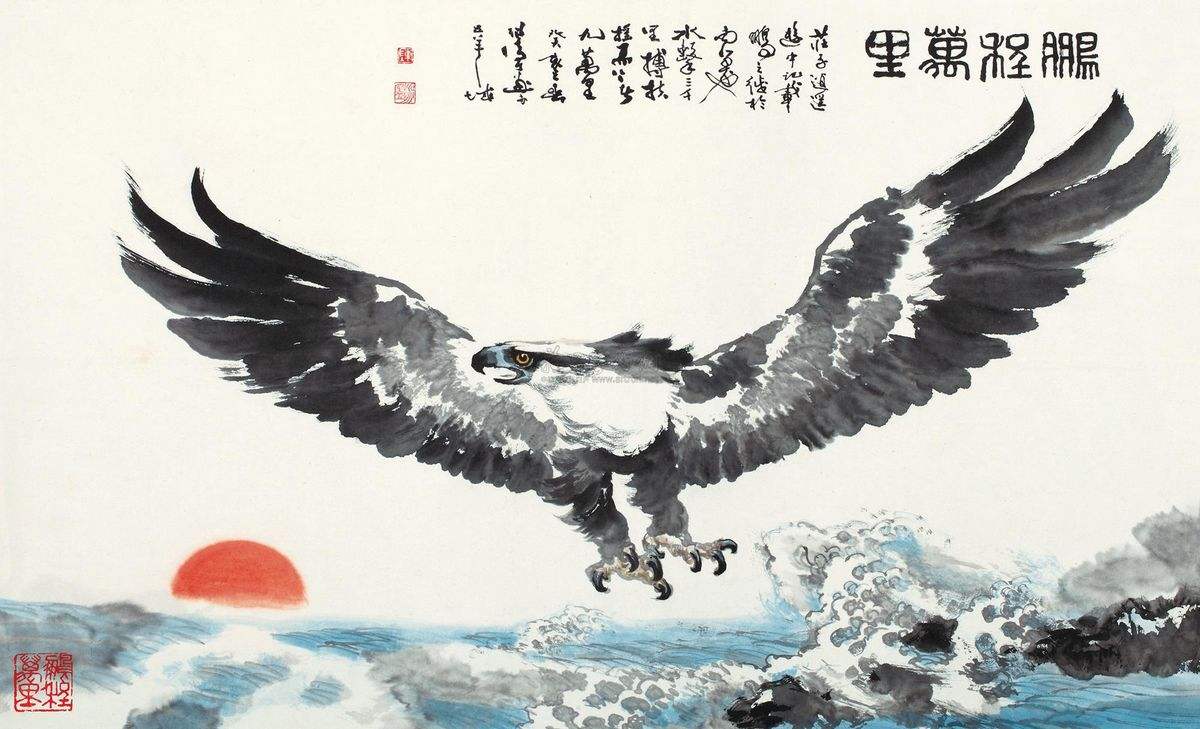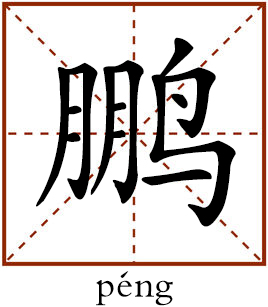Peng symbolizes great aspiration, indomitable will

The image of peng, a giant bird in Chinese mythology, soaring high in the sky is a symbol of great aspiration and indomitable will in Chinese culture.

Peng refers to a giant bird in Chinese mythology. With its back covering thousands of li and wings like clouds that hang from the sky, the peng soaring to a height of 90,000 li high in the sky are a symbol of great aspiration and indomitable will in Chinese culture.
Peng refers to a giant mythical bird in Chinese mythology. The image of peng, ever since its creation by Chuang Tzu (369-c.286 BCE) in accordance with folklore of the pre-Qin period, has appealed to scholar-officials for thousands of years. This symbol has enduring vitality in Chinese history of literature. The character “peng” is frequently picked by Chinese people as a name for male children.
The fact that stories of peng originate from folklore increased its mysterious nature. With its profound cultural and historical connotations, the symbolism of this creature opens a window to understand Chinese aesthetic psychology, especially the ideal personality and spiritual pursuit of ancient Chinese scholar-officials.
Origin, connotations
As a literary image, peng first appeared in the works of Chuang Tzu. His article Wandering in Absolute Freedom goes “In the North Sea there is a kind of fish by the name of kun, whose size covers thousands of li (one kilometer equals two li). The fish metamorphoses into a kind of bird by the name of peng, whose back covers thousands of li. When it rises in flight, its wings are like clouds that hang from the sky. When the wind blows over the sea, the peng moves to the South Sea, also known as the Celestial Pond.”
In order to add credibility to his story, Chuang Tzu quoted descriptions from the Qixie, a collection of mysterious stories. According to the Qixie, “On its journey to the South Sea, the peng flaps spray for 3,000 li and soars to a height of 90,000 li at the windy time of June.” It does seem that the Qixie contained an earlier record of the peng than the works of Chuang Tzu. However, Chuang Tzu was a writer famous for his fables. Whether the book Qixie really existed or it was simply fabricated by Chuang Tzu, remains an open question.
In addition to this, the stories that King Wen ( ? – 677 BCE) of Chu Kingdom once captured a baby peng can also be found in literature written a millennium later, which made the recordings unreliable. Hence, it would be more likely that Chuang Tzu made a vivid description of the peng on the basis of previous records or tales. And the popular adoption of peng images in literary works since then, can be largely attributed to what Chuang Tzu shaped in his work.
Disputes about peng symbolism in Chuang Tzu’s work mostly focused on the issue whether the peng is in a state of “Absolute Freedom.” One faction of scholars including Xiang Xiu (c.227-272), Guo Xiang (252-312) and Shi Deqing (1546-1623), despite their disagreement on the size of the peng, agreed that peng were in a state of absolute freedom.
For example, Guo Xiang said that despite the fact that the cicada, turtle-dove and the peng were of different sizes, they all followed their natural courses. They had no differences in terms of pursuing absolute freedom. Although they had different opinions about cicada and turtle-doves, Shi Deqing and Luo Miandao agreed that peng flying high in the sky and the kun diving deep into the ocean were symbols of a person who was guided by the Tao of nature.
The other faction of scholars argued that the peng was not in a state of Absolute Freedom because they could not fly high in sky without the support of the wind. Absolute Freedom means being free from any kind of support and following only the Way. In this sense, peng were not, strictly speaking, in Absolute Freedom.
Despite all these disputes, there is no doubt that the peng in Chinese literature had various aspects of symbolism. First of all, the peng is a grand and strong creature. Its back “covers thousands of li” and its wings “are like clouds that hang from the sky.” Its huge body contains enormous power, so when flapping its wings, it stirs the water within 3,000 li and soars to a height of 90,000 li. There is no other image as powerful as the peng in this world.
The peng also had great aspiration and persistent pursuit of brightness and freedom. Before metamorphosing into a peng, it was a giant kun fish in the North Sea. By refusing to follow the beaten track and having the courage to transform itself, it metamorphoses itself into a giant peng flying high in the sky. Bidding farewell to the cold and dark ocean, the peng chose to change and pursue more freedom.
The peng also symbolizes a person pressing forward with an indomitable will and who continues to fight despite all setbacks. Birds or insects that fly low among the forests, including yanque (swallow and sparrow), tiao (cicada), xuejiu (turtle-dove) and chiyan (quail) were opposite images that were frequently used to serve as a foil to the peng’s great aspirations.
Chuang Tzu wrote that “A cicada and a turtle-dove derided the peng, saying ‘We fly upwards until we alight on an elm or a sandal tree. Sometimes when we cannot make it, we just fall back to the ground. What is the sense of soaring to a height of 90,000 li on your journey to the South?’ If you plan to go to the green suburbs, you only have to bring three meals and will come back with a full stomach. If you are going 100 li away, you have to grind enough grain for the overnight stay. If you are going 1,000 li away, you have to bring enough grain to support you three months. How could these two little creatures know about all these?”
A quail in the marsh laughed at the peng, saying, “Where does he think he’s going? I hop and skip, and fly up, but I never fly up more than a dozen meters before I come down and hover above the reeds. That is the highest I ever fly! And where does he think he’s going?” The derision and sarcasm of these mediocre birds without lofty aspirations could never stop a determined mind as the peng. Once it has made up its mind, nothing will stop it from fulfilling its aspirations.
Historical evolution
Generations of poets and writers absorbed enormous strength from the image of peng. They also injected their feelings, ideas as well as expectations and pursuits into the peng symbolism. On the one hand, the spirit of freedom symbolized by the peng was strengthened and solidified by demonstrating the pursuit of free personality that was not restricted by the worldly temptation. On the other hand, the peng gradually carries an aspiration of contributing to the nation and benefiting society, demonstrating an enthusiastic enterprising spirit.
Ruan Ji (210-263) once wrote “The turtle-doves flew in the forest, the peng hangs above the sea. Not that the turtle-doves is unaware of the sea beyond. But his wings cannot take him there.” Ruan Ji had great aspirations to contribute to the nation. However, in a time when “the nation is turbulent and seldom can well-known scholars die a natural death,” he did not get the opportunity, and he felt like a peng with its wings tied up. He was frustrated by this fact and comforted himself by saying it was acceptable to be turtle-doves who at least would be able to live a normal life.
In his Ode to the Peng, Ruan Xiu, nephew of Ruan Ji, wrote that “Aspiring to wondering between the Heaven and the Earth, [A peng] disdains to serve a position in the imperial court…Transcending this world and disappeared in sight, he was understood by no one in this world.” The peng in this case carries the writer’s contempt for positions of the imperial courts and transcendent aspirations.
Great poet Li Bai (701-762) was one of the most well-known writers for his excellent use of the peng symbolism in his works. To some extent, Li found himself in the image of peng. Injecting himself into the peng image with unique personality that was vigorous and unrestrained by conventions as well as the enterprising ethos of his time, Li Bai greatly improved the artistic image of peng.
The peng image in the literary works of Li Bai had two different kinds of ethos. The first one is free from any constraints. For example, “If once together with the wind the peng could rise; He would fly ninety thousand li up to the skies. Even if he must descend when the wind has abated; Still billows will be raised and the sea agitated.”
The other kind of peng image in Li Bai’s works showed the more tragic beauty of a hero fighting against fate. The poem On Death’s Bed, which is believed to have been written before he passed away, was a typical work of this kind. The poem goes “When flies the peng he shakes the world; In mid air his weakened wings are furled. The wind he’s raised still stirs the sea; He hangs his left wing on sun-side tree. Posterity mine, hear, O, hear! Confucius dead, who’ll shed a tear?” This poem revealed the sorrow and feelings that there was nothing else that he could do to change the world despite of his life-long efforts in fighting against reality as the peng did in shaking the world.
Although slightly different in detailing the peng, in both these two types of works, Li Bai used the peng to symbolize a person who has great enthusiasm and aspiration. Even when the peng broke their wings during the process of pursuing what he aspired, Li Bai still considered that their efforts would inspire the people of generations to come.
(edited by CHEN ALONG)
